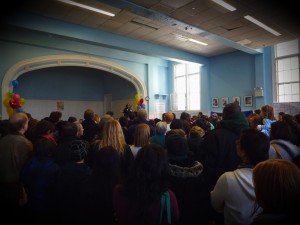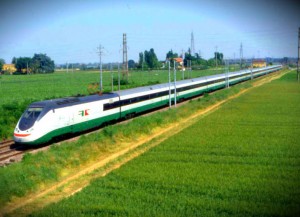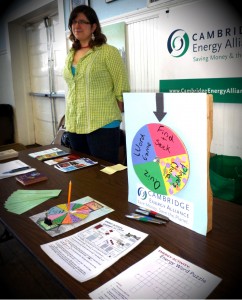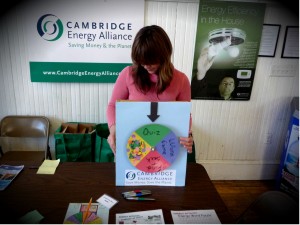Green jobs, no longer just an environmental buzz phrase, represent a critical component to the progressive growth of the US economy. On February 23rd, the Department of Labor’s Employment and Training Administration (ETA) announced the availability of $40 million in green jobs development grants. The funds are authorized for the Green Jobs Innovation Fund (GJIF) and are meant to encourage the growth of the green economic sector, which includes everything from renewable energy technology and implementation, to policy and programmatic work. The announced grant will also support individual training and development within the green jobs sector to ensure interested candidates receive the proper credentials to be competitive within the green economy.
The High-Speed Rail Future?
Following the release of President Obama’s 2012 federal budget, buzz around high speed rail projects in the US has increased. In the budget, $8 billion is allocated for high speed rail projects in FY 2012 and $53 billion is allocated over the next six years. Vice President Biden, a self-proclaimed train lover and regular rider, stated recently “We know that public infrastructure investment increases private-sector productivity, promotes growth, and creates jobs.”
Nevertheless, debate on up-front costs, accessibility and ridership continues to haunt the high-speed rail future in the US, even though Ray LaHood, the current Secretary of Transportation, believes that no realistic alternative currently exists that makes more sense stating “…there is no amount of money that could build enough capacity on our highways and at airports to keep up with our expected population growth in coming decades. America’s population will grow by 70 million in the next 25 years and 100 million in the next 40 years. Adding capacity to an interstate highway in the congested Northeast would cost more than $40 million per mile and cause enormous traffic backups, assuming we even had the space. A relatively “inexpensive” airport runway can cost half a billion dollars to construct.” From LaHood’s quote alone, it’s clear an alternative to the existing train, car and airplane must take tangible shape, and soon.
High-speed rail is already regularly and heavily used in other parts of the world – France’s TGV, Japan’s Shinkansen and Shanghai’s Maglev Train to name a few of the successful lines. SNCF, the company that operates the TGV in France, has in fact proposed its services to the US a number of times with little to no movement from the US government. In addition, Talgo, a Spanish-owned rail manufacturer, recently set up business operations in Milwaukee, Wisconsin hiring more than 100 American workers with anticipated growth, however, when Governor Scott Walker closed the door on Wisconsin’s high-speed rail segment, Talgo ended its operations in that region and moved out. Amtrak’s Acela, which runs along the bustling Northeast corridor between Washington, DC and Boston, has demonstrated great success and high ridership, yet cannot match the high-speeds of TGV or Shinkansen, for example, due to federal speed regulation and existing landscape challenges. Nevertheless, high-speed rail segments are currently in plan and construction in Illinois and California with the aim of more to come.
That said, President Obama’s 2012 budget highlights the need to move high-speed rail to the front and center of the economic agenda. High-speed rail creates long-term domestic jobs, decreases carbon emissions through an efficient method of mass transportation and connects US business centers and cities in a much more streamlined, accessible – and rapid – way than what currently exists. As Ray LaHood said, “President Obama is launching a high-speed rail network that will serve 80% of Americans and its legacy will be more than trains, tracks, and ties. It will be an economy on the move and a future that we are prepared to win.”
Federal Efforts for Energy Efficiency
In the 2011 State of the Union Address, President Barack Obama highlighted many goals as part of the administration’s “winning the future” campaign. Energy efficiency was one such goal, and last Thursday the President, speaking at Penn State, unveiled the Better Buildings Initiative, a plan for a 20% improvement in energy efficiency in commercial buildings by 2020. It’s no coincidence the plan was reveled at Penn State, a school with more than 500 researchers working on energy and environmental studies. The President touted Penn State as a leader in the research towards a clean energy future.
The initiative also strives to reduce companies’ energy bills by $40 billion per year. The plan aims to achieve these goals through a number of different approaches, including tax incentives, loans, and challenges to turn the private sector towards the mind set that clean energy is a worthwhile investment.
In the plan, five main points are presented to achieve these goals.
- Tax incentives – A call to redesign tax code, this would create more incentives through tax breaks and credits for businesses to make energy efficiency improvements to their properties.
- More financing opportunities – Through a recent increase in loan size limits, the Small Business Administration is encouraging current lenders to promote loans made specifically for small businesses to improve the efficiency of their buildings. Also, a new pilot program is proposed in the President’s budget that will guarantee loans for improvements on hospitals, schools, and other commercial buildings.
- Promote state and local governments to encourage energy efficiency in the private sector – The President’s proposed budgets will include new competitive grants for state and municipal governments to encourage the private sector to invest in energy efficiency upgrades to commercial buildings. This is important because many codes, regulations, and standards on commercial energy efficiency are set and controlled by state and local governments.
- The Better Buildings Challenge – The President will challenge CEOs and University Presidents to become leaders in the movement of commercial building energy efficiency by making those leading the way eligible for benefits that include public recognition, technical assistance, and access to “best-practices sharing” within a network of like minded peers.
- Training the next generation of commercial building technology workers – The plan looks to provide more transparency around energy efficiency performance, and provide better training in energy auditing and building operations.
To show the government is truly behind its aspirations for energy efficiency, President Obama issued an executive order to federal agencies, directing them to achieve zero net energy by 2030. Among the requirements, all new constructions and alterations must employ high performance and sustainable design principles. As a mark of progress of this Executive Order, at least 15% of existing federal buildings must meet these principles by 2015.
As for the energy efficiency in the homes of American families, this particular plan does not touch on the subject, but it builds off of the proposed “HOMESTAR” legislation, which encouraged Americans to make energy saving upgrades to their homes. While the house passed the Home Star Energy Retrofit Act of 2010, it never came to vote in the Senate. The President says his remains committed to passing this legislation.
As 2012 approaches, President Barack Obama will be starting to campaign for reelection in the coming months. Look for energy efficiency policy to be a big part of his “winning the future” campaign unveiled during the State of the Union Address last month.
America’s #1 Demand? Clean Energy.
In a recent GOOD article, it was noted that a remarkable 83% of Americans want to see legislative support for clean energy projects according to a current Gallup poll; solar and wind energy specifically received greatest mention. This data is especially eye-opening since this percentage tops the list of all other current major American policy agendas, including health care, taxes and the withdrawal of troops from Afghanistan.
Of course, not all the energy-related responses supported 100% clean, renewable energy — 65% favored an “energy bill that expands drilling and exploration for oil and gas.” A significant percentage of respondents also showed support for both clean energy incentives and expanded fossil fuel extraction, illustrating that climate change, or general environmental concerns, are not as high a priority as energy independence. That said, 83% is a notable level of popular support. Now, will Congress actually listen to the voice of the American people? It will be interesting to watch this issue further develop and unfold over the coming months.
Green Communities Act
Many Massachusetts residents want to live in a healthy and thriving green community, but don’t know how or where to start considering many of the broader environmental challenges that are so vast they can be paralyzing. With such a wide assortment of programs, subsidies and rebates, it can be a challenge for Massachusetts residents to stay on top of state and local energy efficiency options available to them [even though some communities have organizations like CEA to help navigate].
One useful state-wide resource was established under the Green Communities Act, which was signed into law by Governor Patrick in July 2008 and created the Green Communities Division within DOER to serve as the hub for all cities and towns on all matters related to energy. The Green Communities Act established the Green Communities Grant Program that provides grant funding to cities and towns and other local governmental bodies. In 2010, fifty-three cities and towns from across the Commonwealth of Massachusetts were designated as Green Communities. To become a Green Community, a city or town must meet the following five criteria as detailed in the program guidelines:
1). Provide for the as-of-right siting of renewable or alternative energy generating facilities, renewable or alternative energy research and development (R&D) facilities, or renewable or alternative energy manufacturing facilities in designated locations.
2). Adopt an expedited application and permitting process under which these energy facilities may be sited within the municipality and which shall not exceed one year from the date of initial application to the date of final approval.
3). Establish an energy use baseline inventory that includes municipal buildings, vehicles, street and traffic lighting, and put in place a comprehensive program designed to reduce this baseline by 20 percent within 5 years of the baseline year.
4). Purchase only fuel-efficient vehicles for municipal use whenever such vehicles are commercially available and practicable.
5). Require all new residential construction over 3,000 square feet and all new commercial and industrial real estate construction to minimize, to the extent feasible, the life-cycle cost of the facility by utilizing energy efficiency, water conservation and other renewable or alternative energy technologies. The recommended method for meeting these criteria is adoption of the Stretch Code, 780 CMR 120.AA, appendix to the MA State Building Code.
While the Green Communities Act has already established a solid base and grant program for communities who wish to participate, it’s important to continue to increase public awareness of grant and education programs associated with the GCA. For example, coordinate state-wide community outreach efforts to expand GCA impact, use GCA success stories to promote more green-community advancement, encourage increased participation in DOER’s Energy Audit Program and utilize Green Communities Regional Coordinators to learn more specifics.
Green Communities Regional Coordinators:
Central Region: Kelly Brown, 627 Main Street, Worcester, MA 01103 (508) 767-2703 / Cell (617) 780-8144
Northeast Region: Joanne Bissetta, 205B Lowell Street, Wilmington, MA 01887, (978) 694-3315 / Cell (617) 823-4029
Southeast Region: Seth Pickering, 20 Riverside Drive, Lakeville, MA 02347 (508) 946-2838 / Cell (617) 780-7156
Western Region: Jim Barry, 436 Dwight Street, Springfield, MA 01103, (413) 755-2232 / Cell (617) 823-4588
Please note, this article will also appear in the MA E-Sierran this spring.
MLK, Many Helping Hands, and CEA (photos within)

Over 400 volunteers listen to Lori Landers' introduction.
This year’s Martin Luther King Day saw an event put on by Many Helping Hands at the Central Square YWCA, which brought together over 400 Cambridge volunteers to create blankets and scarves for the homeless, emergency room activity kits for children, valentines for home-bound seniors, and bookmarks for literacy program participants.
The day opened with an introduction by the organizers, and then a single vocalist on stage singing a chill-inducing “River Jordan” before leading the crowd in “This Little Light of Mine,” all a cappella to send them off to work with the right spirit firmly in mind.
The Cambridge Energy Alliance was fortunate enough to have been present for this event, among many other local Cambridge volunteer-seeking groups. In addition to getting connected with volunteers, myself and Meghan Shaw were able to interact with residents: adults were able to ask their energy efficiency questions and sign up to take advantage of their Free home energy assessment, while children (see photos below) had a blast playing our new energy efficiency game.
This event had a wonderful turn-out, and we look forward to being a part of such impactful gatherings on MLK days in the years to come.
Everyday Smart Alternatives to Car Congestion Woes
Sick of traffic? Tired of the long, isolated commute to and from the office? You’re not alone, and many analysts say it’s only going to get worse. In fact, according to a recent Grist article, Texas A&M just released its Urban Mobility Report, a report that quantifies just how much of a toll daily commuting and car congestion take on your physical, financial and emotional well being. Not to mention how much personal time you lose sitting idle in traffic. It was also reported that metro Chicago and DC are the worst-off given the current “years delay per auto commuter” index. Astoundingly, Chicagoan and Washingtonian car commuters lose 70 hours of their lives to rush-hour traffic every year. These cities are, not surprisingly, followed closely by Los Angeles at 63 hours and Houston at 58 hours.
Thankfully, there are alternatives if you’re willing to alter your lifestyle a bit and are willing to get to know your neighbors. Relay Rides, a startup that just launched recently in Boston, aims at car sharing as a better, more transparent modern-day model for car users. Riders can “rent out” their car by the hour to those in need of wheels. Need an extra incentive? The owner can make upwards of a few thousand dollars a year just by doing so, and insurance is covered by Relay Rides. There are also (of course) Zipcar and City CarShare in San Francisco, to name a few.
If you’re not into cars, and you live in an urban center, there are often subway lines or buses you can take. While at first many people dismiss public transportation in the US as old and unreliable, it’s an essential public service that needs consumer support to thrive and improve. Imagine if each person you saw on the T coming home from work was instead driving? How many more cars would be added to the road? It’s simply unfathomable. So, instead of festering in your car each day with road rage, explore your options for car sharing, or public transportation. Or, simply good old fashioned car-pooling. You get to meet new people, plus it’s good for your soul and the environment!
2005 and 2010 Tied for Hottest Years on Record
The NYTimes recently cited that current NASA data matches NOAA data making 2005 and 2010 the two hottest years on Earth in recorded history. [NASA data is available here.]
From extreme flooding in Pakistan, California, Australia and Tennessee, to significant snow fall in England and France, to raging fires in Russia and extreme heat in New England, 2010 was indeed a notable weather year. While climate deniers continue to correlate varying weather patterns with the natural cycle of the Earth, climatologists disagree stating that the global average surface temperature was 1.12 degrees Fahrenheit above the average for the entire 20th century. In fact, according to the NYTimes article, 9 of the 10 warmest years on record have occurred since the year 2000. It will be interesting – and perhaps startling – to see what occurs in 2011. This data is a reminder that climate change is real, and immediate global action, both political and personal, is imperative to maintain a healthy, livable planet for all.
Massachusetts = Belgium?
A recent Sierra Club magazine article illustrates, in a unique diagram, how the United States, with 4.5% of the world’s population, is responsible for nearly 20% of global carbon dioxide emissions. In fact, state by state, U.S. CO2 output equals that of entire countries, as illustrated on the map. Data are from the 2007 U.S. Energy Information Administration.
Speaking with Climate Change Skeptics
 Feel like banging your head against the wall each time you try to discuss climate change with someone you know? Below is a highly valuable blog entry that was spawned from climate change concensus-building expert Larry Susskind‘s participation in a CEA/HEET-sponsored event. Here, Mr. Susskind thoroughly discusses how best to communicate with those who are critical of climate change’s legitimacy. Ultimately you must work around confrontation by facts, to get to the heart of concerns for each conversation partner. If you have been experiencing difficulty communicating with skeptics in your life, this is a blog for you.
Feel like banging your head against the wall each time you try to discuss climate change with someone you know? Below is a highly valuable blog entry that was spawned from climate change concensus-building expert Larry Susskind‘s participation in a CEA/HEET-sponsored event. Here, Mr. Susskind thoroughly discusses how best to communicate with those who are critical of climate change’s legitimacy. Ultimately you must work around confrontation by facts, to get to the heart of concerns for each conversation partner. If you have been experiencing difficulty communicating with skeptics in your life, this is a blog for you.
—
From Larry Susskind’s blog, The Consensus Building Approach:
On Wednesday, November 10th, I had an opportunity to speak to a packed room of students and community residents at Harvard College seeking advice on how to talk to climate skeptics. The premise was that students would soon be heading home for Thanksgiving. They were looking for advice on how to talk to family and friends around the holiday table who either don’t believe that global warming is happening, or accept the fact that the climate is getting warmer, but attribute relatively recent temperature changes to natural rather than man-made causes. To get things started, we heard from a local radio talk show host who really is a climate skeptic. He made it very clear that he doesn’t trust Al Gore, is sure that scientists disagree about almost everything (because that’s what science requires), and thinks that anyone who believes that climate change is the result of human activity (rather than cyclical natural phenomena) has been sold a bill of goods.

![Operating a hand drill at North American Aviation, Inc., [a] woman is working in the control surface department assembling a section of the leading edge for the horizontal stabilizer of a plane, Inglewood, Calif. (LOC) by The Library of Congress](http://farm3.static.flickr.com/2024/2179861666_7bcd3bbbbb_m.jpg)



![[Tree in a rural area] (LOC) by The Library of Congress](http://farm3.static.flickr.com/2091/2179176502_90bbbc4f4c_m.jpg)








